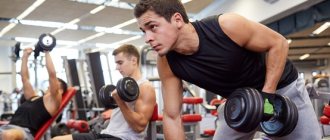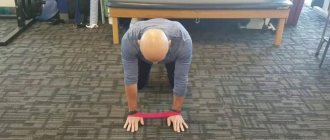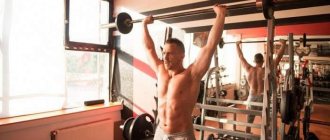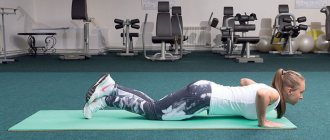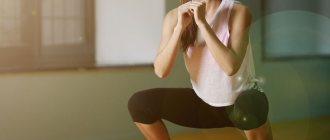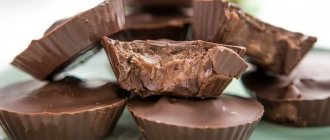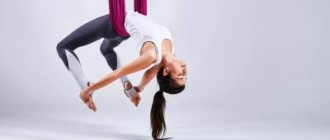Diamond push-ups
A very effective exercise for the triceps and upper chest. Include it in your daily workout, and your arms will soon improve significantly.
Get into plank position, keep your back straight, and don’t lower your head. Place your hands so that your index fingers and thumbs form a triangle. Straighten your arms, the triangle of fingers should be located exactly under the chest.
Lower your body to the floor, paying attention to the work of your elbow joints. At the lowest point, touch your chest to your hands, fix your body for a few seconds, then straighten your arms, raising your torso to the starting position.
In the gym
If you work out in the gym, then finding an exercise that replaces the uneven bars is easier. Among the many options, there are several that are most effective.
Close grip bench press
This exercise has many benefits.
- It is a complex exercise - when it is performed, all the heads of the triceps are involved, thereby improving its development.
- In this exercise you can achieve maximum mass, strength and a combination of these two parameters.
- Allows you to improve the quality of the classic bench press.
- The easiest exercise to perform that allows you to achieve high performance.
Bench push-ups
The technique of performing this exercise helps to increase the strength and mass of the triceps. When combined with other basic exercises, you can make serious progress in gaining muscle mass.
In addition, performing such an exercise diversifies your workout, which has a beneficial effect on the development of muscle tissue.
French bench press
When performing this exercise, many beginners make various mistakes.
- Elbows should be kept at the same level throughout the entire approach. They must be stationary, otherwise there is a high risk of injury.
- There is no need to come up with something unusual, for example, placing your feet on a bench. This does not change the load on the triceps, but it is more difficult to maintain balance.
- Under no circumstances should you throw your head back behind the bench. This position does not affect the muscles in any way, but increases intracranial pressure, which is extremely undesirable during strength training.
- Don't skip warming up. If you miss it, your risk of injury increases.
French press standing
This exercise has certain benefits.
- Promotes good development of strength and volume of the arms.
- The three heads of the triceps are involved.
- Better muscle stimulation.
- Improves the quality of classic bench press performance.
- Stability of shoulder and elbow joints.
Archer push-ups
One-arm push-ups are great for developing chest muscles. It is not easy to perform them; it is recommended to start with one repetition, gradually increasing their number.
Keeping your body in plank pose, place your arms wider than shoulder-width apart. Slowly lower your torso down: one arm works as in a normal push-up, the other remains straight and slides to the side. Stop when you feel that you cannot support your body on one arm.
Slowly return to the starting position and repeat the exercise on the other arm. Ideally, you need to touch your chest to the floor, but this does not work the first time.
Plyometric leg training
Most often, plyometrics are used to train explosive leg strength and improve jumping performance. Below are the main points you need to pay attention to when performing jumps to get the most out of them. The correct technique gives the best results.
- Keep your knees over your toes If your knees tend to roll inward when you land, try to point them outward as soon as your feet hit the ground. This will avoid unnecessary stress on the knee joints, and therefore possible injuries.
- Throw Your Arms Your arms are a useful tool in creating momentum for your jump. In order to learn how to throw your arms correctly and synchronize this movement with the jump itself, it will take some time. But it's worth it!
- Exercise on a Soft Surface The surface on which you perform your exercises plays a big role. Landing too hard puts unwanted stress on your knees, which can lead to injury. So try to find a suitable place to study. Sand, earth, rubber coating, etc. will do.
- Fully straighten your legs All jumps must be performed to full extension, that is, all joints must be straightened during the jump.
Exercises
Wide jumps - for distance
- Single or Series
- Single/Double
- Pistol
Jumping onto a box - to maximum height
- Single/Double
- Pistol
- One step/two steps/running
Jumping on stairs - the further and higher, the better
- Single/Double
- Pistol
- One step/two steps/running
Jumping from a height - followed by a high/distance jump
- Single/Double
- Single or Series
- The exercise requires preliminary preparation and is not recommended for beginners.
Explanations for execution
Bilateral exercise - performed using both legs.
Unilateral exercise - performed using one of the legs.
Pistollet - performed on one leg, followed by squatting on it to full amplitude.
Single reps – reps are performed one at a time with a pause after each one.
Series of repetitions - repetitions are performed one after another at a pace without a pause.
Single step jump – performed after a step that imparts some moment of force.
Two-step jump - performed after two steps, which are used to generate more torque.
Running jump - performed from a running start, which allows you to obtain an even greater moment of force than a two-step jump.
Spider-Man
Exercise for reflexive strength and core strengthening. In addition, it activates nerve impulses between the brain and muscles, developing a reaction.
Standing in plank pose, begin to lower yourself to the floor. At the same time, bend your right leg and touch your knee to your right elbow. Lower your body as low as possible, keeping your back straight. Hold at the bottom for a few seconds and then return to the starting position.
Repeat the exercise on the left side. Take your time: the slower the movements, the more effort you have to put into keeping your body in the desired position.
How to replace crunches
Experts recommend replacing crunches with a regular plank. This static exercise is almost universal. It perfectly develops the muscles of the core, legs, back and upper body. Moreover, the exercise itself has a high fat burning potential. Nowadays, different options for making the plank have been developed. For example, some types of exercise focus directly on the obliques.
What to plant in the garden to get rid of mosquitoes? Marigolds, lavender and 10 others
I picked strawberries from the garden, bought fresh mangoes and made chocolate cake: recipe
Pisces in “Romeo and Juliet”: DiCaprio’s characters by zodiac sign
Angled push-ups
A complex exercise that develops the chest, shoulders and back. By changing the position of your legs, you can work all muscle groups.
Get into a push-up position with your legs on a platform or bench, keeping them straight. The higher the support, the more difficult the exercise.
Slowly lower your body down, touching your chest to the floor. Keep your back straight, do not arch your lower back. Return to the starting position.
Plyometric exercises with visual graphics
In fact, the entire variety of available plyometric exercises comes down to just a few basic ones, and the rest are their author’s variations.
The plyometric complex, in turn, is compiled depending on which muscle groups need to be trained.
Contraindications: diseases of the cardiovascular and respiratory systems, problems with the musculoskeletal system (joints), excessive excess weight.
Basic, basic plyometric exercises
- Jumping on legs (respectively legs)
- Jumping push-ups (triceps and chest)
- Pull-ups on the bar (back)
- Throwing heavy objects at each other (lumbar and core muscles). A medicine ball (a ball filled with sand) can be used as a weight.
Plyometric exercises of low and medium complexity (graphics)
| Exercise | Graphic arts |
| 1. Jumping from a straight plank in a diagonal direction | |
| 2. Jump Squats | |
| 3. Squats with arms and legs raised while jumping | |
| 4. Squats (half squats) with jumping on one leg | |
| 5. Squats with a jump turn | |
| 6. Speed Skater | |
| 7. Spiderman push-ups | |
| 8. Squats with jumping and changing the width of the legs | |
| 9. Jumping Lunges | |
| 10. Straight plank jumps |
Advanced plyometric exercises (graphics)
| Exercise | Graphic arts |
| 1. Burpee with jumping | |
| 2. Push-ups with a ball | |
| 3. Jumping onto the platform | |
| 4. Burpee (simplified version) | |
| 5. Push-ups with supports |
Explosive push-ups
A variation of regular push-ups, performed at the fastest possible pace. Develops muscles, trains reaction speed and explosive strength, speeds up metabolism and quickly burns calories.
While standing in plank pose, slowly lower your body down and then quickly return to the starting position with your arms fully extended. The movement should be sharp and clear. Repeat as many times as you can.
Neuromuscular synapse
Explosive exercises (such as jumping jacks, jumping jacks), or push-ups with a clap and lifting the body, develop neuromuscular synapse, or rather explosive strength. In simple terms, the speed at which the spinal cord can send a signal to contract is relatively small. At the same time, an untrained body, regardless of the load, sends a limited number of impulses. That is why there is a “false” opinion that all pitching is slow. After all, as the size of the muscle fiber increases, it needs more nerve impulses to stimulate contraction.
Explosive exercises specifically stimulate the ability of the spinal cord and brain to send more impulses. Due to this, the athlete’s speed performance increases. And due to the increase in the number of signals, more muscle fibers are involved. Those. in explosive exercises, the entire triceps contracts – including the deepest “reserve layers”.
Push-ups with cotton
A complex exercise suitable only for advanced athletes. The pectoralis major muscles, latissimus dorsi, core and triceps work actively. It is dangerous, it is better to perform it on a soft surface.
Get into plank pose with your palms slightly wider than shoulder-width apart. Lower your body down, touching your chest to the floor. Do an explosive push, lift your palms off the floor and clap the air. Land softly on your palms, elbows slightly bent, and lower your body down again. Repeat the exercise several times.
Common mistakes
How to properly do push-ups from the floor with a narrow grip in order to avoid mistakes and achieve results faster?
- Control the position of your body, do not arch your back, do not stick out your buttocks;
- The elbows cannot be spread to the sides, because in this case the entire load goes to the back and pectoral muscles;
- At the top point, the arms are not fully straightened (to increase the load), and at the bottom they do not lie on the floor, supporting themselves by weight;
- Breathe correctly - lower as you inhale, rise as you exhale;
- Work smoothly - do not jerk or pause.
If you still don’t fully understand how to learn to do push-ups with a narrow grip, watch the video that we have attached for you. This way you will clearly see the correct technique and clarify unclear points.

